|
|
If you are reading these rules for the first time, ignore the text along the right hand side. These rules serve as a summary to help you quickly familiarize yourself with the game.
Show
→ summary only
→ detailed version only
→ both summary and detailed version

Lorenzo il Magnifico
In Lorenzo il Magnifico, each player takes the role of a head of a noble family in Florence during the Renaissance. You must accumulate
prestige and fame to gain more Victory Points than the others. To do so, you will send your family members to different areas of the
city where they can attain various achievements. In some areas, you will get useful resources. In others, you will get development cards
representing new territories, sponsored buildings, influenced characters or encouraged ventures. Elsewhere, you can activate the effects
of these cards. Family members are not identical. At the beginning of each round, 3 dice are rolled to determine the family members’
value. You must carefully choose where to send your family members with a higher value.
There are several ways to gain Victory Points, but you must also pay attention to your relations to the Church. The game is divided into
3 periods, each formed by 2 rounds. At the end of each period, players must show their faith. Anyone who hasn’t prayed enough will
suffer harsh penalties. After 6 rounds, you will calculate your final score and the player with most Victory Points will be the winner.
Components
1 board
4 Personal boards
4 Personal Bonus Tiles
Coins
3 dice (white, black, orange)
Wooden resources:
Wood (16 small, 4 large)
Stone (16 small, 4 large)
Servant (18 small, 5 large)
16 Family Members (each player has 3 colored pawns and 1 uncoloured pawn)
16 Marker Discs
12 Excommunication Cubes (3 for each player color)
21 Excommunication Tiles
4 Covering Tiles
96 Development Cards (4 types divided into 3 Periods)
20 Leader Cards
Setup

|
1
|
Place the Board in the center of the table.
|
|
2
|
Separate the Development Cards by type
and period (color and back number). Shuffle
each deck (formed by 8 cards) separately.
Create 4 different decks
(one for each type
of card)
by placing third period cards on
the bottom, second period cards in the
middle, and first period cards on the top.
Place the decks next to the board, near
the towers.
|
|
3
|
Separate the Excommunication Tiles
by period (back number), shuffle them
separately, then draw one tile from each
stack and place them in the appropriate
space on the board.
(Place the leftover tiles
back in the box.)
|
|
4
|
Place the resources and coins next to the
board. They form the general supply.
Small resources count as 1. Large resources
count as 5. Resources are considered to
be unlimited.
(If you run out, find a way to
take note of the resources you receive).
|
|
5
|
Place the 3 Dice next to the Board
|
|
6
|
In a 2-player game, place all the
Covering Tiles in the appropriate spaces
(with the  and
and  symbol). symbol).
In a 3-player game, place the 2 small
Covering Tiles in the appropriate spaces
(with the  symbol). symbol).
|
|
7
|
Each player chooses a color and receives:
-
a A Personal Board
-
b 1 Personal Bonus Tile. (In the basic game, all players use this side.)
-
c 3 Family Members of their color and the uncolored Family
Member with the sticker of their color
-
d 3 Excommunication Cubes
-
e 4 Marker Discs. Place 1 disc each on the 0 step of the Victory
Points track, Military Points track, and Faith Points track,
respectively. Place the last disc on the Turn Order track.
See
 on the right. on the right.
-
f 2 wood, 2 stone, 3 servants
|
|
8
|
Randomly choose the turn order and place the marker discs on
the Turn Order track.
|
|
9
|
The first player receives 5 coins, second player receives 6 coins,
third player receives 7 coins, fourth player receives 8 coins.
|
Lorenzo il Magnifico is played in 3 periods, each
divided into 2 rounds, for a total of 6 rounds.
Each round is divided into 4 phases.
-
Round Setup
-
Actions
-
Vatican Report (only during round
2, 4, 6 at the end of a Period)
-
End of the Round
Lorenzo il Magnifico is a complex strategic game. Here
we present the rules for the basic game to introduce play.
To play a full game, read the Advanced Rules section
and integrate them with the basic rules.
-
Round Setup
-
Actions
-
Vatican Report (only during round
2, 4, 6 at the end of a Period)
-
End of the Round
Lorenzo il Magnifico is played in 3 periods, each
divided into 2 rounds, for a total of 6 rounds.
Each round is divided into 4 phases.
-
Draw Development Cards.
-
Roll the dice and place them on the board.
-
Draw 4 Development Cards from the top of
each deck and place them in the appropriate
spaces of the board, from bottom to top.
-
The First player rolls the dice and places
them on the appropriate spaces on the board.
Place one of your Family Members in an action space and perform the corresponding action.
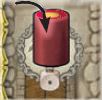 To take an action, you must place
one of your Family Members in
an action space and perform the
corresponding action.
To take an action, you must place
one of your Family Members in
an action space and perform the
corresponding action.
Each Family Member can
perform an action at the value of
its corresponding die.
The neutral Family Members have
a value of 0.
The minimum value needed for
every action is depicted inside
the die symbol under the action
space.
Before placing a Family Member, you can
always spend servants to increase the Family
Member’s value, in a 1:1 ratio, without limit.
It is not allowed to spend more servants than you need!
Following Turn Order, players must take their actions.
 To take an action, you must place
one of your Family Members in
an action space and perform the
corresponding action.
To take an action, you must place
one of your Family Members in
an action space and perform the
corresponding action.
For example,
if you rolled a 4 on the white die,
all Family Members with the white
die symbol on top will have a value
of 4 during the current round).

On top of each Family Member,
there is a symbol
(a colored or a
neutral die)
. This symbol is related
to the value of the corresponding
die.
Each Family Member can
perform an action at the value of
its corresponding die.
The neutral Family Members have
a value of 0.
(The colored sticker
reminds that an uncolored Family
Member belongs to a certain player.)
For some actions, you will need a
Family Member of value 1. For
other actions, you will need higher
values. Some actions allow you
to decide your Family Member’s
value depending on your needs.
The minimum value needed for
every action is depicted inside
the die symbol under the action
space.
For example, you can spend 3 servants to increase
your uncolored Family Member’s value to 3.
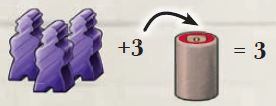
Note: A Family Member with a certain value can
always take an action that requires a lower value.
Before placing a Family Member, you can
always spend servants to increase the Family
Member’s value, in a 1:1 ratio, without limit.
It is not allowed to spend more servants than you need!
There are 5 different areas where you can place your Family
Members. Different rules are applied to the action spaces in
different areas.
There are 4 Towers, each with 4 floors. On every
floor, there is an action space that allows the player
to take the corresponding card and, if present,
some bonuses.
All cards, Territories excepted, have a cost indicated
in their upper left corner.
Most cards have an immediate effect. This is
indicated in the middle part of the card, beside
the flash symbol.
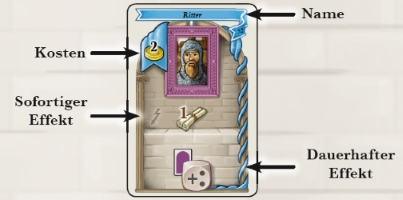
For a list of possible immediate and permanent effects
see here.
There are 4 Towers, each with 4 floors. On every
floor, there is an action space that allows the player
to take the corresponding card and, if present,
some bonuses.
If a player cannot pay a card he may not choose the
corresponding action.
The Cards
There are 4 different types of Development Cards:
Territories (green), Buildings (yellow), Characters
(blue), and Ventures (purple).
All cards, Territories excepted, have a cost indicated
in their upper left corner. When you have to take a
card
(as an effect of a Family Member placed or another
card’s immediate effect)
, you must always pay its cost.
Most cards have an immediate effect. This is
indicated in the middle part of the card, beside
the flash symbol. You may receive resources,
Points (Victory, Military or Faith) or bonus actions.
These bonus actions could be taking a card
without placing a Family Member or performing
a Harvest/Production action.
Most cards have a permanent effect. This is
indicated in the lower part of the card. Each type
of card has a permanent effect that is activated in
a different way.

For a list of possible immediate and permanent effects
see here.
Territories don’t have a cost, but it is not that simple
to conquer new territories.
The first 2 left spaces are always available. The others
will become available when your military power
increases.
You don’t have to spend the required Military Points. You
only have to have them in the moment you place
the card.
Territories are an important source of goods. Their
permanent effects are activated with a Harvest
action.
Territories don’t have a cost, but it is not that simple
to conquer new territories. To take a new Territory
Card, you must place it in the first free space on the
left of your Personal Board (in the lower line).

The first 2 spaces are always available. The others
will become available when your military power
increases. On every space of the lower line of your
Personal Board (except the first 2), you can see the
number of Military Points required to place a card
there. You don’t have to spend Military Points. You
only have to have them in the moment you place
the card.
(After you have placed a card, the requirement is
covered and you can forget it.)
Territories are an important source of goods. Their
permanent effects are activated with a Harvest
action.
In addition, they provide Victory Points at the end
of the game in relation to the total number of
Territory Cards you have.
(See End of the Game and Final Scoring)
Buildings always cost resources
(wood, stone, servant, coin) to acquire them.
Buildings provide resources or allow you to exchange
a resource for either another resource or Points. Their
permanent effects are activated with a Production
action.
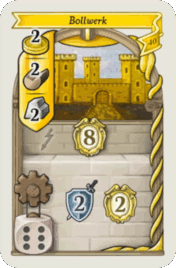
Buildings always cost resources
(wood, stone, servant, coin). When you
acquire a Building Card, you must
spend the required resources and
return them to the general supply.
If you don’t have the required
resources, you can’t take the card.
Place the Building in the appropriate space on your
Personal Board (in the upper line) from left to right.

Buildings provide resources or allow you to exchange
a resource for either another resource or Points. Their
permanent effects are activated with a Production
action.
Characters only ever cost coins to acquire them.
Characters’ permanent effects are activated in
specific circumstances
(usually when you are performing
another action)
. Some of them give a bonus to the
action value, some provide a discount on the costs.
Characters only ever cost coins. When you acquire a
Character Card, you must spend the required coins
and return them to the general supply. If you don’t
have the required coins, you can’t take the card.
Place the card in a line beside your Personal Board
(in the lower right corner).

Some Characters’ immediate effects may give you
the ability to perform a bonus action without using
your Family Members. In this case, all rules are
applied normally to that action.
Characters’ permanent effects are activated in
specific circumstances
(usually when you are performing
another action)
. Some of them give a bonus to the
action value, some provide a discount on the costs.
In addition, Character Cards provide Victory Points at
the end of the game in relation to their total number.
(See End of the Game and Final Scoring.)
Ventures cost resources or Military Points.
Some Venture Cards have a double cost, which
means you can choose which cost to pay.
Ventures’ permanent effects are always activated
at the end of the game during Final Scoring.
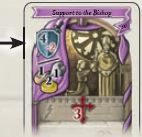
This symbol means that you must
pay 2 Military Points and may
do so only if you have at least 4
Military Points before taking the
card. (Move your disc back on
the Military Track.) -
OR pay using resources.
Ventures cost resources or Military Points.
Some Venture Cards have a double cost, which
means you can choose which cost to pay. If you
don‘t have the resources or Points required, you
can‘t place the Family Member to take the card.
Place the card in a line next to your Personal
Board (in the upper right corner).
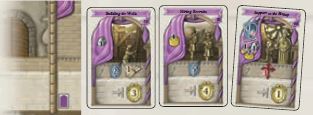
Ventures’ permanent effects are always activated
at the end of the game, when you calculate the
final scoring. (See End of the Game and Final Scoring
on page 11.)
Rules for placing a Family Member on a tower
-
Place a Family Member on a tower floor.
(It must have a value equal to or higher than the
value required by the action space. If there are already
Family Members in the same tower, pay 3 additional
coins to the supply. There can’t be 2 Family Members
of the same color in the same tower.)
- Take the bonus if present.
-
Pay the cost of the card
(and if it is a
Territory, you must have the Military Points required)
.
-
Take the card and place it on your personal
board. Apply the immediate effect of the card
if present.
-
The Family Member you want to place here
must have a specific value, depending on the
floor where you will place it:

|
On the first floor, you must place
Family Members of value 1 or more.
|

|
On the second floor, you must place
Family Members of value 3 or more.
|

|
On the third floor, you must place
Family Members of value 5 or more.
|

|
On the fourth floor, you must place
a Family Member of value 7 or
more. To place here, you must
spend at least 1 servant or have a
card power that increases a Family
Member’s value
|
-
There is no rule regarding the placement
order on the floors. (Players don’t have to place on
the first floor first.)
-
Beside the action spaces on the third and
fourth floor, you will find some bonuses:
1 or 2 wood, 1 or 2 stone, 1 or 2 Military
Points, 1 or 2 coins. When you place a Family
Member in one of these spaces,
immediately receive the bonus.
You may use this bonus to pay the
cost of the card you want to take.
-
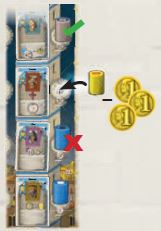 If there are Family Members
(one or more, yours or of other
players) already present in
the same tower where you
want to place your Family
Member, you must pay
3 coins to the supply before
placing it. If you place in a
space that gives coins as a
bonus, you can’t use them to
pay these 3 additional coins.
If there are Family Members
(one or more, yours or of other
players) already present in
the same tower where you
want to place your Family
Member, you must pay
3 coins to the supply before
placing it. If you place in a
space that gives coins as a
bonus, you can’t use them to
pay these 3 additional coins.
-
There can’t be two Family
Members of the same color
in the same tower. Uncolored
Family Members are considered
to be of a neutral color. (A single
player can take 2 cards from the same
tower in the same round, but only
using their uncolored Family Member
or using a card effect.)
-
After taking a card, place it in the
corresponding space of your Personal Board:
Territories on the lower line, Buildings on the
upper line, Characters on the lower right,
Ventures on the upper right. If the card has
an immediate effect, resolve it now.
-
You may not have more than 6 cards of the
same type on your Personal Board.
Recap: Place a Family Member on a tower
floor.
(It must have a value equal to or higher than the
value required by the action space. If there are already
Family Members in the same tower, pay 3 additional
coins to the supply. There can’t be 2 Family Members
of the same color in the same tower.)
Take the bonus
if present. Pay the cost of the card
(and if it is a
Territory, you must have the Military Points required)
.
Take the card and place it on your personal
board. Apply the immediate effect of the card
if present.
Both of these areas are divided into two action
spaces. The first action space on the left may contain
only one Family Member. The larger action space
on the right may contain any number of Family
Members. (This space is not available in 2-players games.)
-
The Family Member you want to place here
must have a value of 1 or higher. The second
section gives a penalty of -3 to the action value.
-
Players may not place two of their colored
Family Members in the two action spaces of
each area, but they can place a colored and the
uncolored Family Member.
-
The value of the Family Members you place
here determines the value of the action. Their
value can be increased by spending servants or
by cards’ effects.
Harvest or Production activates
- the corresponding personal bonus
-
the permanent effects of all Territories or Buildings on your Personal Board, but only of
those that have a value equal to or lower than your action value.
All the resources you want to use to activate the
exchanging effects
(those effects that change a resource
into another)
must already be present in your
personal supply before starting the activation.
(You can’t use resources that you received from a
permanent effect for another building’s permanent effect.)

Both of these areas are divided into two action
spaces. The first action space on the left may contain
only one Family Member. The larger action space
on the right may contain any number of Family
Members. (This space is not available in 2-players games.)
-
The Family Member you want to place here
must have a value of 1 or higher. The second
section gives a penalty of -3 to the action value.
To place a Family Member here, you must
activate an action at value 1 or higher.
Players may not place two of their colored
Family Members in the two action spaces of
each area, but they can place a colored and the
uncolored Family Member.

The value of the Family Members you place
here determines the value of the action. Their
value can be increased by spending servants or
by cards’ effects.
-
Harvest activates the corresponding personal
bonus and the permanent effects of all
Territories on your Personal Board, but only of
those Territories that have a value equal to or
lower than your Harvest action value.
-

 Production activates the corresponding personal
bonus and the permanent effects of all Buildings
on your Personal Board, but only of those
Buildings that have a value equal to or lower
than your Production action value.
Production activates the corresponding personal
bonus and the permanent effects of all Buildings
on your Personal Board, but only of those
Buildings that have a value equal to or lower
than your Production action value.
-
Personal bonus is indicated
on your Personal Bonus Tile
beside your Personal Board.
This bonus is activated with an
action at value 1, so it is always
activated when you perform a
Harvest/Production action.
Activating permanent effects
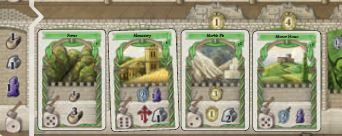
You place a Family Member with a value of 3 on the first
Harvest action space. You have 2 servants in your personal
supply and decide to spend them to increase your action
value up to 5. You receive 1 wood, 1 stone, and 1 servant
from your Personal Bonus Tile; 3 wood from the Forest;
2 Military Points and 2 servants from the Manor House;
and 1 Victory Point and 2 stone from the Marble Pit.
You don’t receive bonuses from the Monastery because it
has an activation value of 6 and your action has a value of 5.
When you activate a line of Territories, you
receive resources and Points from the activated
cards. In addition, you receive bonuses from
your Personal Bonus Tile.
When you activate a line of Buildings, you
activate their permanent effects. In addition, you
receive bonuses from your Personal Bonus Tile.
All the resources you want to use to activate the
exchanging effects
(those effects that change a resource
into another)
must already be present in your
personal supply before starting the activation.
(You can’t use resources that you received from a
permanent effect for another building’s permanent effect.)
To remember, place the resources you want to
use from your personal supply on the cards that
will use those resources before activating.
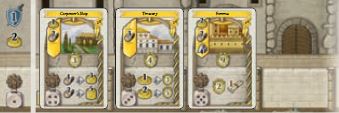
You place a Family Member with a value of 6 on the second
Production action space, so your action has a value of 3.
You can decide
-
not to spend servants and activate only the Treasury
and the personal bonus. You gain 1 Military Point and
receive 2 coins from the Personal Bonus Tile and you
spend 1 or 2 coins to gain 3 or 5 Victory Points
-
to spend 1 servant to also activate the Carpenter’s Shop.
You spend 1 wood to receive 3 coins or 2 wood to
receive 5 coins
-
to spend 2 servants to also activate the Fortress. You
receive 1 Council Privilege and gain 2 Victory Points
In any case, you can’t use the coins you receive from the
Personal Bonus Tile (or from the Carpenter’s Shop) to
activate the Treasury. You must already have the coins in
your personal supply before the activation.
There is one action space in the Council Palace.
This space may contain any number of
Family Members. There can be more than
one of any color of Family Member in the
Council Palace.
(A player may place multiple
Family Members in this action space.)
-
Immediately receive 1 Council Privilege and 1 coin.
-
At the end of each round, Turn Order
changes in relation to the order in which
Family Members are placed in the Council
Palace.
1 Council Privilege is a bonus of your
choice between:

1 wood and 1 stone / 2 servants / 2 coins /
2 Military Points / 1 Faith Point
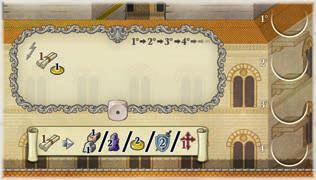
There is one action space in the Council Palace.
-
This space may contain any number of
Family Members. There can be more than
one of any color of Family Member in the
Council Palace.
(A player may place multiple
Family Members in this action space.)
-
The Family Member you want to place here
must have a value of 1 or higher.
-
When you place in the Council Palace, place
the Family Members in order from left to right.
-
Immediately receive 1 Council Privilege and 1 coin.
Note: At the end of each round, Turn Order
changes in relation to the order in which
Family Members are placed in the Council
Palace. (See End of the Round.)
Council Privilege is a bonus of your
choice between:

1 wood and 1 stone / 2 servants / 2 coins /
2 Military Points / 1 Faith Point
This phase only occurs in rounds 2/4/6.
Faith Points required: 3/4/5 Faith Points for Period 1/2/3, respectively.
There are 3 different possibilities:
-
If a player does not have the Faith Points
required at the end of a Period, they are
not able to support the Church and will suffer
an Excommunication.
-
If a player does have the Faith Points
required at the end of a Period, they can decide to support or not to support the Church.
If they decide not to support it, they will suffer
an excommunication as if they did not have
the required level of Faith Points.
Excommunicated players must place one of their cubes on the
Excommunication Tile of the current period.
From now on, they will suffer the negative
effects of their excommunication. They leave
their disc on the Faith Points track where it is.
Players who decide to support the Church
must spend all their Faith Points to prevent
themself from receiving an excommunication.
The players receive the Victory Points indicated on the
step of the Faith track they are currently on.
Then they move their marker back to the first
step of the Faith track.
At the end of the 6th Round, the players who
suffer excommunication, gain the Victory
Points indicated on the step of the Faith track
they are currently on.
This phase only occurs in rounds 2/4/6. There
is no round marker in the game. You must look
at the Development Cards to calculate the
round, if you don’t remember it. If the cards on
the top of the decks are a different period than
the cards on the board, then it is an even round.
During this phase, players must show their
support to the Church through their Faith Points.

Each period has a certain amount of Faith
Points required: 3/4/5 Faith Points for Period
1/2/3, respectively. This is indicated on the
Faith Points track.
There are 3 different possibilities:
-
If a player does not have the Faith Points
required at the end of a Period (their marker on
the Faith track isn’t on the required step), they are
not able to support the Church and will suffer
an Excommunication. Excommunicated
players must place one of their cubes on the
Excommunication Tile of the current period.
From now on, they will suffer the negative
effects of their excommunication. They leave
their disc on the Faith Points track where it is.

If a player does have the Faith Points
required at the end of a Period (their marker
on the Faith track is on the required step or further),
they can decide to support or not to support
the Church.
-
If they decide not to support it, they will suffer
an excommunication as if they did not have
the required level of Faith Points. They must
place their cube on the Excommunication
Tile of the current Period and suffer the
negative effects of their excommunication
from now on. They leave their disc on the
Faith track where it is.
-
If they decide to support the Church, they
must spend all their Faith Points to prevent
themself from receiving an excommunication.
However, the Pope will thank them with a
certain amount of Victory Points. The players
receive the Victory Points indicated on the
step of the Faith track they are currently on.
Then they move their marker back to the first
step of the Faith track.

After the Actions phase of round 2, the red player has 2
Faith Points and does not have the 3 Faith Points required
by the first Period Vatican Report. They suffer the first
Period Excommunication. They leave their disc where it is.

The green player has 3 Faith Points and can decide whether
or not to support the Church.
If not, they suffer
Excommunication
and leaves their disc
where it is.
If they support the
Church, they gain
3 Victory Points and
move their disc back
to the 0 space of the
Faith track.
(Suffering an excommunication will give you
negative effects for the rest of the game, but
it preserves your Faith Points.)
At the end of the 6th Round, the players who
do not have the Faith Points required, after
suffering excommunication, gain the Victory
Points indicated on the step of the Faith track
they are currently on. Then they move their
marker back to the first step of the Faith track.
For a detailed description of Excommunication
Tiles, see the Appendix.
-
Take all the faceup Development Cards from
the board.
-
Change the Turn Order following the order
of the Family Members placed in the Council
Palace.
Players who didn’t place a Family Member in the Council
follow in their relative order.
-
Players then move their Family Members
from the Board to their Personal Board.
At the end of the round, perform the following
actions.
-
Take all the faceup Development Cards from
the board. They won’t be used again in this
game.
-
Change the Turn Order following the order
of the Family Members placed in the Council
Palace. The player who placed first becomes
first player for the next round. Place their
disc on the first space of the Turn Order,
and so on with other players. If some players
didn’t place a Family Member in the Council
Palace, they remain in their relative order.
Uncolored Family Members count for the
Turn Order as well. If a player placed more
Family Members here, the first on the left
is counted for Turn Order. If there are no
Family Members in the Council Palace, leave
the Turn Order as it is.
-
Players then move their Family Members
from the Board to their Personal Board.
You are now ready to start the following round.
The game ends at the end of the sixth round,
after the End of the Round phase.
Final Scoring indicated by symbol  . .
-
Conquered Territories: 1/4/10/20
Victory Points for 3/4/5/6 Territory Cards
-
Influenced Characters: 1/3/6/10/15/21
Victory Points for 1/2/3/4/5/6 Character Cards
-
Encouraged Ventures: The sum of all
Victory Points on the Venture Cards
-
Military Strength: If there
is a tie between first players,
they all gain 5 Victory Points
and nobody gains 2 Victory
Points. If there is a tie between
second players, they all gain 2
Victory Points.
-
Collected Resources: 1 Victory Point for
every 5 resources of all types.

The player with most Victory Points is the winner.
In case of a tie, the player more advanced on
the Turn Order is the winner.
The game ends at the end of the sixth round,
after the End of the Round phase. You can now
calculate the Final Scoring.
Players will score Victory Points for the following
results, indicated by symbol  . .
-
Conquered Territories: 1/4/10/20
Victory Points for 3/4/5/6 Territory Cards
on your Personal Board.

-
Influenced Characters: 1/3/6/10/15/21
Victory Points for 1/2/3/4/5/6 Character
Cards next to your Personal Board.

-
Encouraged Ventures: The sum of all
Victory Points on the Venture Cards next to
your Personal Board.

-
 Military Strength: If there
is a tie between first players,
they all gain 5 Victory Points
and nobody gains 2 Victory
Points. If there is a tie between
second players, they all gain 2
Victory Points.
Military Strength: If there
is a tie between first players,
they all gain 5 Victory Points
and nobody gains 2 Victory
Points. If there is a tie between
second players, they all gain 2
Victory Points.
-
Collected Resources: 1 Victory Point for
every 5 resources of all types. (Add all the
resources together, then divide the result by 5.)

The player with most Victory Points is the winner.
In case of a tie, the player more advanced on
the Turn Order is the winner.
Setup
Each player chooses a Personal Bonus Tile and places it next to their Personal Board.
Shuffle the Leader Cards and give 4 cards
to each player. Choose 1 card to keep and
pass the others to the player on your right.
Continue drafting cards until each player has
4 cards.
Leader Cards
Each Leader card has some
requirements you must satisfy
to play it. These are indicated
in the upper part of the card.
Requirements are not costs. You
don‘t have to pay them.
Each Leader has a special ability that is either
Once Per Round or Permanent, indicated in
the lower part of the card.
-
Once Per Round abilities give you bonuses
when you activate it with a Leader Action (see
below). These effects can be activated only once
per round.
-
Permanent abilities usually have effects that are
applied in specific circumstances, so they can be
applied more than once per round.
Leader Actions
During their Actions Phase, players may
perform one or more special actions without
placing a Family Member. These instant actions
can be performed at any time, before or after
placing their Family Member.
-
Discarding a Leader Card from your hand and immediately
receive a Council Privilege.
-
Playing a Leader Card from your hand if
you satisfy the Leader requirements.
- Activating a Leader’s Once Per Round Ability
To play the full game, add these advanced rules. A setup
rule provides the ability to customize your Personal
Bonus Tile. Then, an important element of the game
is introduced: the Leader Cards. These cards are used in
the Actions phase. They have strong special abilities, but
you will need to satisfy some requirements to play them.
Setup
-
Instead of taking a Personal
Bonus Tile, place them with
the advanced side faceup
on the table. In a reverse
turn order, each player
chooses a Personal Bonus
Tile and places it next to
their Personal Board.
-
Shuffle the Leader Cards and give 4 cards
to each player. Choose 1 card to keep and
pass the others to the player on your right.
Continue drafting cards until each player has
4 cards.

Each Leader card has some
requirements you must satisfy
to play it. These are indicated
in the upper part of the card.
Requirements are not costs. You
don‘t have to pay them. You only
need to have them when you play
the card. (It doesn’t matter if you lose some
requirements afterward.)
Each Leader has a special ability that is either
Once Per Round or Permanent, indicated in
the lower part of the card.
Once Per Round abilities give you bonuses
when you activate it with a Leader Action (see
below). These effects can be activated only once
per round.
Permanent abilities usually have effects that are
applied in specific circumstances, so they can be
applied more than once per round.
(For a detailed description of Leader cards, see the Appendix.)
Leader Actions
During their Actions Phase, players may
perform one or more special actions without
placing a Family Member. These instant actions
can be performed at any time, before or after
placing their Family Member.
Leader actions cannot be performed in the middle of eventual effects which were triggered by placing your Family Member.
Discarding a Leader Card
You can decide to discard a Leader card from
your hand. If you do so, you immediately
receive a Council Privilege. You may do this
more than once per turn.
Playing a Leader Card
You can play a Leader Card from your hand if
you satisfy the Leader requirements. Place the
Leader card face up next to your Personal Board.
You may do this more than once per turn.
Activating a Leader’s Once Per Round Ability
Turn the Leader Card face down and resolve
its “Once Per Round” Ability. You may activate
more than one card per round.
End of the Round
Turn facedown Leader cards faceup.
Take the depicted number of resources or Points
Perform a specific action at a specific value without placing a Family Member
Pay the resources or Points on the left to
receive the resources or Points on the right,
only one time per activation (if there are two
arrows, you must choose which one to execute)
Receive the coins or Victory Points on the left for each
number of Cards or Military Points on the right you have
When buying a Development Card of the specified type (shown left of
the discount), you get the card at a discount of the resources shown.
When you are performing a specific action
(Harvest, Production, or Taking a specific
Card), increase your action value by the
depicted number of dots
You don’t take the bonuses when
you take a Development Card from
the third and the fourth floor of the
towers (through a Family Member or
as an effect of another card.)
Leader cards
Francesco Sforza
Requirement:
5 Venture Cards
Effect (Once per Round):
Perform a Harvest action at value 1. (You can increase this action value
only with servants; you can't increase it with Farmer or Peasant Development Cards)
Ludovici Ariosto
Requirement:
5 Character Cards
Effect (permanent):
You can place your Family Members in occupied action spaces.
Filippo Brunelleschi
Requirement:
5 Building Cards
Effect (Permanent):
You don't have to spend 3 coins when you place you Family Member
in a Tower that is already occupied.
Federico Da Montefeltro
Requirement:
5 Territory Cards
Effect (Once Per Round):
One of your coloured Family Members has a value of 6, regardless of its related die.
You can activate this effect before selecting the Family Member you want to use this turn.
Girolamo Savonarola
Requirement:
18 Coins
Effect (Once Per Round):
Gain 1 Faith Point.
Giovanni Dalle Bande Nere
Requirement:
12 Military Points
Effect (Once Per Round):
Receive 1 wood, 1 stone and 1 coin.
Sandro Botticelli
Requirement:
10 wood
Effect (Once Per Round):
Gain 2 Military Points and 1 Victory Point.
Michelangelo Buonarroti
Requirement:
10 stones
Effect (Once Per Round):
Receive 3 coins
Ludovico III Gonzaga
Requirement:
15 servants
Effect (Once Per Round):
Receive 1 Council Privilege.
Leonardo Da Vinci
Requirement:
4 Character Cards and 2 Territory Cards
Effect (Once Per Round):
Perform a Production action at value 0. (You can increase this
action value only with servants; you can't increase it with
Artisan or Scholar Development Cards).
Pico Della Mirandola
Requirement:
4 Venture Cards and 2 Building Cards
Effect (Permanent):
When you take Development Cards, you get a discount of 3 coins (if the card you are taking has coins in
its cost). This is not a discount on the coins required to place in a tower already occupied.
Sisto IV
Requirement:
6 Wood, 6 Stone, 6 Coins and 6 Servants
Effect (Permanent):
You gain 5 additional Victory Points when you support the Church in a Vatican Report phase.
Lucrezia Borgia
Requirement:
6 Development Cards of the same type
Effect (Once Per Round):
Your coloured Family Members have a bonus of +2 on their value (You can increase their value with
servants or Character Card effects.
Sigismondo Malatesta
Requirement:
7 Military Points and 3 Faith Points
Effect (Permanent):
Your uncoloured Family Member has a bonus of +3 on its value. (You can increase their value with
servants or Character Card effects).
Lorenzo De' Medici
Requirement:
35 Victory Points
Effect (Once Per Round):
Copy the ability of another Lead Card already played by another player.
Once you decide the ability to copy, it can’t be changed.
Ludovico Il Moro
Requirement:
2 Territory Cards, 2 Character Cards, 2 Buildings and 2 Venture Cards
Effect (Permanent):
Your coloured Family Members have a value of 5, regardless of their related dice. (You can increase their
value with servants or Character Card effects).
Cesare Borgio
Requirement:
3 Building Cards, 12 Coins, 2 Faith Points
Effect (Permanent):
You don't need to satify the Military Point requirement
when you take Territory Cards.
Santa Rita
Requirement:
8 Faith Points
Effect (Permanent):
Each time you receive wood, stone, coins or servants as a immediate effect from a Development Cards
(not from Action spaces) you receive the resources twice.
Cosimo De' Medici
Requirement:
2 Character Cards and 4 Building Cards
Effect (Once Per Round):
Receive 3 Servants and gain 1 Victory Point
Bartolomeo Colleoni
Requirement:
2 Venture Cards & 4 Territory cards
Effect (Once Per Round):
Gain 4 Victory Points.
Each time you gain Military Points
(from action spaces or from your Cards)
, gain 1 fewer Military Point.
If you have more Cards that give you Military Points,
consider each Card a single source, so you gain -1 Military Point for each Card.
Each time you receive Coins
(from action spaces or from your Cards)
, you receive 1 fewer Coin.
If you have more Cards that give you coins,
consider each Card a single source, so you receive -1 coin for each Card.
Each time you receive servants
(from action spaces or from your Cards)
, you receive 1 fewer servant.
If you have more Cards that give you servants,
consider each Card a single source, so you receive -1 servant for each Card.
Each time you receive wood or stone
(from action spaces or from your Cards)
, you receive 1 fewer wood or stone.
If you have more Cards that give you wood or stone,
consider each Card a single source, so you receive -1 wood or stone for each Card.
Each time you perform a Harvest action
(through the action space or as a Card effect)
, descrease its value by 3.
You may still spend servants to increase
the action value and you must apply your Card's effects.
(If you place in the second action space, your action value is decreased by 6)
Each time you perform a Production action
(through the action space or as a Card effect)
, descrease its value by 3.
You may still spend servants to increase
the action value and you must apply your Card's effects.
(If you place in the second action space, your action value is decreased by 6)
All your colored Family Members receive a -1 reduction of their
value each time you place them.
(For example, if you roll a 5 on the black die, your Family Member with the
black die symbol has a value of 4)
You may still spend servants to increase
their value and you must apply your Card's effects.
Each time you take a Territory Card
(through the action space or as a Card effect)
,
your action receives a -4 reduction of its value.
You may still spend servants to increase
the action value and you must apply your Card's effects.
Each time you take a Building Card
(through the action space or as a Card effect)
,
your action receives a -4 reduction of its value.
You may still spend servants to increase
the action value and you must apply your Card's effects.
Each time you take a Character Card
(through the action space or as a Card effect)
,
your action receives a -4 reduction of its value.
You may still spend servants to increase
the action value and you must apply your Card's effects.
Each time you take a Venture Card
(through the action space or as a Card effect)
,
your action receives a -4 reduction of its value.
You may still spend servants to increase
the action value and you must apply your Card's effects.
You can't place your Family Members in the Market action spaces.
You have to spend 2 servants to increase your action value by 1
(and 4 servants to increase it by 2, and so on...).
Each round, you skip your first turn.
(When you have to place your first Family Member, you have to pass.)
You start taking actions from the second turn (in the appropriate turn order).
When all players have taken their turns, you may still place your last Family Member.
At the end of the game, you don't score points for any of your Influenced Characters.
At the end of the game, you don't score points for any of your Encouraged Ventures.
At the end of the game, you don't score points for any of your Conquered Territories.
At the end of the game, before the Final Scoring, you lose 1 Victory Point for every
5 Victory Points you have. (For example, if you have 26 Victory Points before the Final Scoring, you lose 5 Victory Points.)
At the end of the game, you lose 1 Victory Point for every
Military Point you have. (For example, if you end the game with 12 Military Points, you lose 12 Victory Points.)
At the end of the game, you lose 1 Victory Point for every wood and stone on your Building Card's costs.
(For example, if all your Building Cards cost 7 wood and 6 stone, you lose 13 Victory Points.)
At the end of the game, you lose 1 Victory Point for every resource (wood, stone, coin, servant) in your supply on your Personal Board.
(For example, if you end the game with 3 wood, 1 stone, 4 coins and 2 servants, you lose 10 Victory Points.)
Your tableau shows the Family Members who are still available for actions. Click the hand above to select the Family Member of your choice.
The active Family Member is displayed half transparent.

If you want to spend additional servants when selecting Harvest or Produce action, please do so before selecting the action space using the spinner. It is not allowed to spend more servants than you need!
Wherever rules left an opening for discussion, basic rules are always applied: you can never use two colored Family Members in the same action group. When a Leader allows to use already occupied spaces, this must still respect the base rule.
Some excommunication tiles from the first era reduce the number of one resource by one when receiving some of that type. This penalty also includes Council privileges when taken as that particular resource.
Excommunications reduce the number of a resource by one when you take it from any source (included Council privileges) and are applied by source.
Combination of excommunication effect if you play the advanced version with Leaders:
Example:
- You receive an immediate Card effect of 1 coin
- You have the leader card which doubles the resources of immediate Card effects
- You receive 1 coin less due to excommunication
- In total, you still receive 1 coin: 1 * 2 - 1 = 1

You can magnify all cards of one type on your tableau by clicking the corresponding symbol in the lower left corner of your tableau ( Example: buildings)
The game board renders correctly on tablet format (1024 x 768 pixels), consider closing the side panel. Playing on devices with smaller screen resolution is not recommended.
| |